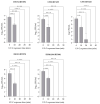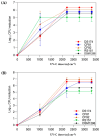Efficacy of UV-C 254 nm Light and a Sporicidal Surface Disinfectant in Inactivating Spores from Clostridioides difficile Ribotypes In Vitro
- PMID: 39599518
- PMCID: PMC11597166
- DOI: 10.3390/pathogens13110965
Efficacy of UV-C 254 nm Light and a Sporicidal Surface Disinfectant in Inactivating Spores from Clostridioides difficile Ribotypes In Vitro
Abstract
Clostridioides difficile is widely recognised as one of the most common causes of healthcare-associated C. difficile infections due to the ability of spores to survive for prolonged periods in the hospital environment. This study aimed to evaluate the efficacy of UV-C 254 nm light in the inactivation of the spores of different C. difficile ribotypes on brain heart infusion (BHI) agar plates or in phosphate-buffered saline (PBS) with varying spore densities. Furthermore, the effectiveness of a sporicidal surface disinfectant against C. difficile spores was determined on different surfaces. Spore suspensions of different C. difficile strains in the range of 105-107 colony-forming units (CFUs) mL-1 were inoculated on BHI agar plates or in PBS and exposed to UV-C light for up to 30 min. Additionally, a spore suspension of 103-105 CFUs was spread over a 1 cm2 test area on different surfaces, and sporicidal surface wipes were used according to the manufacturer's instructions. The findings demonstrated that spores of C. difficile ribotypes exhibited a complete reduction in log10 CFU on BHI agar plates and PBS following 20 min of exposure to a UV-C dose of 2208 mJ cm-2. The surface wipes with sporicidal properties demonstrated efficacy in reducing the number of C. difficile spores on the Formica, stainless steel, and plastic surfaces by 2.03-3.53 log10. The present study demonstrates that moist surfaces or liquids can enhance the efficacy of UV-C treatment in reducing C. difficile spores. This approach may be applicable to the surfaces of healthcare facilities and to water disinfection systems.
Keywords: Clostridioides difficile; UV-C light; disinfectant; ribotypes; spores; sporicidal; sporicidal surface wipes.
Conflict of interest statement
The authors declare no conflicts of interest.
Figures







Similar articles
-
Disinfectant wipes transfer Clostridioides difficile spores from contaminated surfaces to uncontaminated surfaces during the disinfection process.Antimicrob Resist Infect Control. 2020 Nov 4;9(1):176. doi: 10.1186/s13756-020-00844-0. Antimicrob Resist Infect Control. 2020. PMID: 33148316 Free PMC article.
-
Effect of UV-C light or hydrogen peroxide wipes on the inactivation of methicillin-resistant Staphylococcus aureus, Clostridium difficile spores and norovirus surrogate.J Appl Microbiol. 2019 Aug;127(2):586-597. doi: 10.1111/jam.14308. Epub 2019 Jun 6. J Appl Microbiol. 2019. PMID: 31077510
-
Efficacy of five 'sporicidal' surface disinfectants against Clostridioides difficile spores in suspension tests and 4-field tests.J Hosp Infect. 2022 Apr;122:140-147. doi: 10.1016/j.jhin.2022.01.010. Epub 2022 Jan 22. J Hosp Infect. 2022. PMID: 35077809
-
Inactivation of Spores and Vegetative Forms of Clostridioides difficile by Chemical Biocides: Mechanisms of Biocidal Activity, Methods of Evaluation, and Environmental Aspects.Int J Environ Res Public Health. 2022 Jan 10;19(2):750. doi: 10.3390/ijerph19020750. Int J Environ Res Public Health. 2022. PMID: 35055571 Free PMC article. Review.
-
How to eradicate Clostridium difficile from the environment.J Hosp Infect. 2015 Apr;89(4):287-95. doi: 10.1016/j.jhin.2014.12.007. Epub 2015 Jan 7. J Hosp Infect. 2015. PMID: 25638358 Review.
Cited by
-
Ultraviolet C Decontamination Devices in a Hospital Pharmacy: An Evaluation of Their Contribution.Pharmacy (Basel). 2025 Jan 25;13(1):9. doi: 10.3390/pharmacy13010009. Pharmacy (Basel). 2025. PMID: 39998007 Free PMC article.
-
Evaluation of the Efficacy of UV-C Radiation in Eliminating Clostridioides difficile from Touch Surfaces Under Laboratory Conditions.Microorganisms. 2025 Apr 25;13(5):986. doi: 10.3390/microorganisms13050986. Microorganisms. 2025. PMID: 40431159 Free PMC article.
-
UV-C and hydration state drive pulsed light-induced proteome damage in Bacillus pumilus spores.Front Microbiol. 2025 Apr 9;16:1579161. doi: 10.3389/fmicb.2025.1579161. eCollection 2025. Front Microbiol. 2025. PMID: 40270826 Free PMC article.
References
MeSH terms
Substances
Grants and funding
LinkOut - more resources
Full Text Sources
Medical

